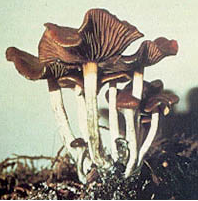Psilocybe cyanescens
"The Potent
Psilocybe"
Although this "wavy caped" mushroom may look like an ordinary mushroom, it is anything accept ordinary. Found in the western region of the United States and throughout Europe, is a psychedelic mushroom, known as Psilocybe cyanescens, the most potent species in the genus Psilocybe. The mushroom's name is derived from the psychoactive alkaloid compounds generated in the mushroom, known as psilocin and psilocybin. The hallucinogenic properties of this mushroom make it very alluring to recreationalists, therefore it is important that you continue reading to further understand this amazing fungus.
Despite the current illegality regarding the psychedelic
properties of this
can be commonly found in a variety of locations. The Ancient
Egyptian culture used the mushroom in religious practices more than
8,000 years ago. The Aztec culture from Mexico documented the first
known use of the mushroom in the United States, to alleviate
toothaches and headaches. However, nowadays cultivation of the
mushroom typically occurs in "domestic operations", mainly to avoid
prosecution from law enforcement. Because this is a fungus, it is
most commonly found located on a bed of woodchips,
or other organic mediums occurring innately in nature.
Wikimedia Commons, September 25, 2005
BASIC CHARACTERISTICS
The Latin or scientific name, known as its etymology, Psilocybe, is derived from "bare headed", which refers to the loose material over the mushroom cap. The species component "cyanescens" refers to the mushroom's innate ability to turn blue when touched or brushed against, which is a form of bruising. In nature, this species of fungus can be harvested from September through December, depending on growing conditions and the regional climate that the mushroom is growing in. If you would like to see more about how this mushrooms grows click on life cycle to see more about the reproduction process. For more information regarding fungal phylogeny, in particular how this species is classified, click on classification.
This website was created by Jacob Akin, a
current student at the University of Wisconsin - La Crosse, in 2013
as part of an Organismal Biology course. For more information
regarding my academic and personal pursuits please click
here!
If you have enjoyed this website then you need to check out the other organisms that other students have made as well, please visit MultipleOrganisms.net to see the works of other students from the University of Wisconsin - La Crosse.
